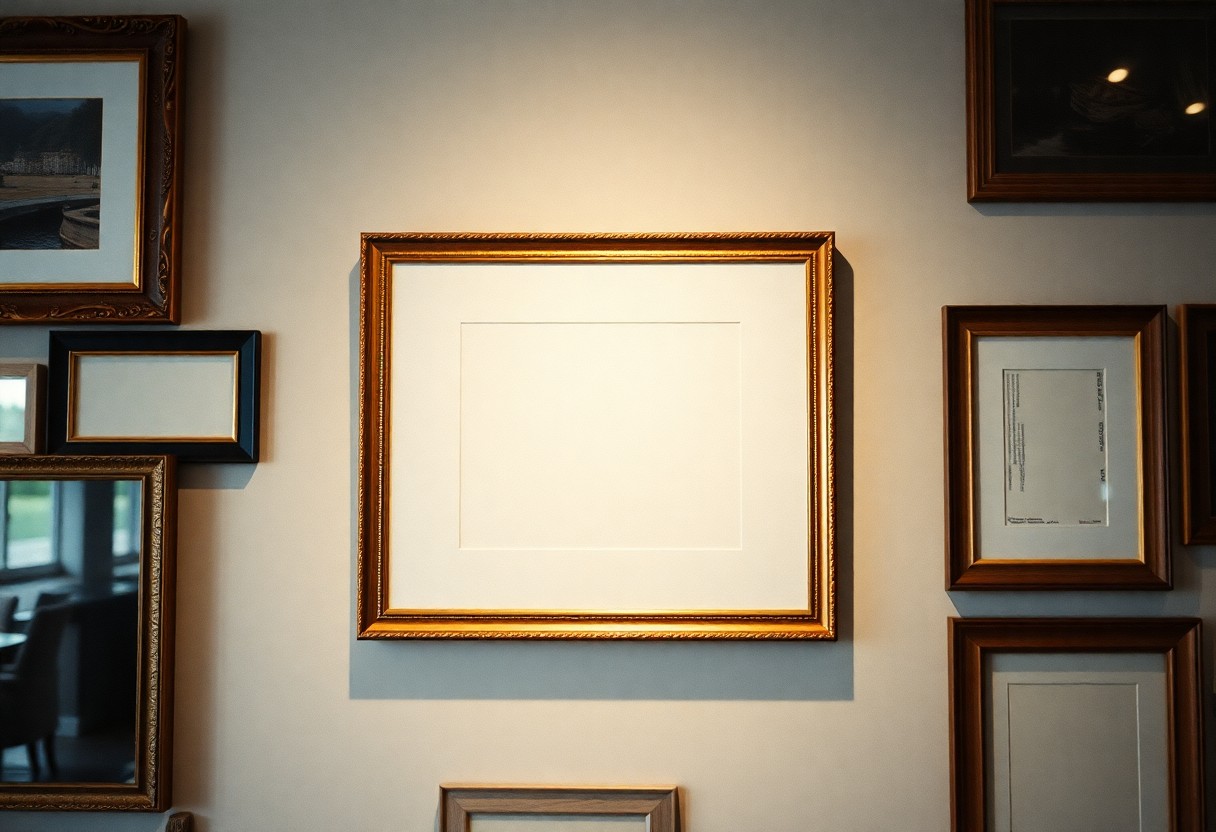Preparation
The process of framing your artwork begins with a thorough preparation stage, where you lay the groundwork for a successful project. You will need to consider several factors, including the type of frame, matting, and glazing, to ensure that your artwork is properly showcased.
Gathering Materials
Along the lines of getting started, you will need to collect all the necessary materials, including the frame, mat board, glass or acrylic, and any other relevant tools, to ensure that you have everything you need to complete the framing process efficiently.
Choosing the Right Frame
Above all, selecting the right frame for your artwork is imperative, as it will greatly impact the overall appearance of the piece. You should consider factors such as the style, color, and size of the frame, as well as the type of artwork you are framing, to ensure that you make an informed decision.
But as you explore deeper into the process of choosing the right frame, you will need to consider your personal style and the overall aesthetic you want to achieve. You should think about the color palette and theme of your artwork, as well as the decor of the room where the piece will be displayed, to ensure that the frame complements and enhances your artwork, rather than overpowering it, and that you are completely satisfied with the final result, which is your beautifully framed artwork.
Key Takeaways:
- When framing your artwork, consider the style and period of the piece to choose a frame that complements its aesthetic, ensuring a cohesive and visually appealing presentation.
- The material and color of the frame should be selected to enhance the artwork’s colors and textures, creating a harmonious balance between the frame and the art.
- The size and proportions of the frame should be carefully chosen to fit the artwork, taking into account the scale and orientation of the piece to create a balanced and polished final product.

Measuring and Planning
Some artwork requires more planning than others, but measuring is an necessary step in framing your artwork. You need to determine the size and shape of your artwork to choose the right frame.
Taking Accurate Measurements
Against the backdrop of your artwork’s unique dimensions, you will need to take precise measurements to ensure a perfect fit. You should measure the width, height, and any irregular shapes or borders.
Considering Frame Styles
Measuring the style of your artwork will help you choose a frame that complements it. You should consider the color, material, and design of the frame to ensure it enhances your artwork.
Consequently, as you explore different frame styles, you will find that certain designs suit your artwork better than others. You can choose from modern, traditional, or minimalist frames, depending on your personal taste and the style of your artwork, to create a harmonious and visually appealing combination that showcases your piece to its fullest potential.

Frame Options
Now that you have decided to frame your artwork, you can choose from a variety of frame options to enhance its beauty and protect it from damage. You can select frames that match your artwork’s style, color, and theme to create a stunning visual effect.
Wooden Frames
Beside the traditional look, wooden frames offer a warm and cozy feel to your artwork. You can choose from various types of wood, such as oak, maple, or cherry, to complement your artwork’s color and style.
Metal Frames
Along with their modern and sleek look, metal frames provide a durable and low-maintenance option for your artwork. You can select from different metal types, such as aluminum or steel, to create a contemporary and sophisticated look.
Even if you prefer a more traditional style, metal frames can be a great option, as they can be designed to resemble wooden frames or other materials. You can also choose from various finishes, such as silver, gold, or bronze, to add a touch of elegance to your artwork.
Matting and Mounting
Once again, the quality of your artwork’s presentation relies on your attention to detail, and matting and mounting are imperative steps in the framing process, as they enhance the overall appearance and protect your artwork from damage.
Selecting the Right Mat
Across various styles and materials, you can choose a mat that complements your artwork, considering factors such as color, texture, and width to create a visually appealing combination that accents your art.
Attaching the Artwork
Attaching your artwork to the mat or mounting board requires careful consideration to avoid damaging the piece, and you should use acid-free materials and techniques to ensure your artwork’s longevity and preservation.
Also, when attaching your artwork, you will want to consider using a variety of methods such as hinging, dry mounting, or spray adhesive, depending on the type of artwork and the desired level of permanence, allowing you to achieve a secure and professional-looking attachment that will protect your artwork for years to come.
Glazing and Finishing
For the final touches on your framed artwork, you will need to consider glazing and finishing options. This stage can enhance the appearance and protection of your piece. You will decide on the type of glaze and finish that suits your artwork best.
Choosing Glass or Acrylic
Besides the frame itself, the glazing material you choose will significantly impact the overall look of your artwork. You can opt for either glass or acrylic, each offering unique benefits such as UV protection, clarity, and durability.
Adding a Finish
Across the various finishing techniques available, you can select one that complements your artwork’s style and theme. You might consider a matte, glossy, or textured finish, each altering the visual effect of your piece.
In addition to the aesthetic appeal, the finish you choose will also affect the longevity of your artwork. You should consider factors like moisture protection, UV resistance, and ease of cleaning when making your decision, ensuring your artwork remains vibrant and well-preserved over time.
Hanging and Display
Not only does the frame enhance the beauty of your artwork, but the way you hang it can also make or break the overall aesthetic. You want to ensure that your framed piece is displayed in a way that showcases its unique qualities.
Selecting the Perfect Location
Along with considering the lighting and wall space, you should think about the surrounding decor and how your artwork will interact with it. You will want to choose a location that complements your piece and allows it to be the focal point.
Hanging Techniques
By using the right hanging hardware and techniques, you can ensure that your artwork is secure and level. You will want to invest in a sturdy hanging system that can support the weight of your framed piece.
Further to this, you should consider the type of wall you are hanging on, as well as the weight and size of your artwork, to determine the best hanging method for your specific situation. You may need to use anchor points or special fasteners to ensure that your piece is securely attached to the wall.
You’ve created a stunning piece of art, and now you want to showcase it in the best possible way. As you consider framing your artwork, you’ll want to think about the style, material, and overall aesthetic you’re aiming for. Your goal is to enhance the piece without overpowering it, and with the right techniques, you can achieve a professional-looking result that showcases your art to its fullest potential, protecting it for years to come while making it a beautiful addition to any room.
To wrap up
To wrap up, you have now gained valuable insights into framing your artwork. You can confidently select the perfect frame to enhance your piece. For more expert advice, visit The working artist: how to frame your artwork to take your skills to the next level and make your artwork stand out. You will be able to make informed decisions about your artwork’s presentation, ensuring your pieces look their best.
FAQ
Q: What is the first step in framing my artwork?
A: The first step in framing your artwork is to choose a frame style that complements the piece. Consider the color, size, and style of the artwork, as well as the decor of the room where it will be displayed. You can choose from a variety of frame styles, including modern, traditional, and ornate, to find the one that best enhances your artwork.
Q: What types of materials can I use to frame my artwork?
A: There are several types of materials you can use to frame your artwork, including wood, metal, and plastic. Wood frames are a popular choice because they are durable and can be stained or painted to match any decor. Metal frames are also popular, especially for modern and contemporary artwork, and come in a variety of finishes such as silver, gold, and bronze. Plastic frames are a budget-friendly option and come in a range of colors and styles.
Q: How do I measure my artwork for framing?
A: To measure your artwork for framing, start by measuring the width and height of the piece. Make sure to measure from the edges of the artwork, not including any margins or borders. You should also consider the thickness of the frame and any mats or glazing you plan to use, as these can add to the overall size of the framed piece. It’s also a good idea to use a level to ensure your measurements are accurate and the frame will hang straight.
Q: What is the purpose of matting in framing, and do I need it?
A: Matting is a thin, acid-free material that is placed between the artwork and the frame to add depth and protection. It helps to separate the artwork from the frame, preventing it from coming into contact with the glass or acrylic glazing, and can also help to enhance the appearance of the piece by adding a border of color. While matting is not necessary, it can be beneficial in preserving the artwork and adding a professional touch to the framing.
Q: How do I hang my framed artwork once it’s complete?
A: To hang your framed artwork, start by choosing a wall with good lighting and a sturdy structure. Use a level to ensure the frame is straight, and a pencil to mark the spot where you want to hang it. Use a sturdy nail or screw to hang the frame, and consider using a hanging kit or D-rings to distribute the weight of the frame evenly. Make sure to hang the frame at a comfortable viewing height, and adjust as needed to achieve the desired display.


